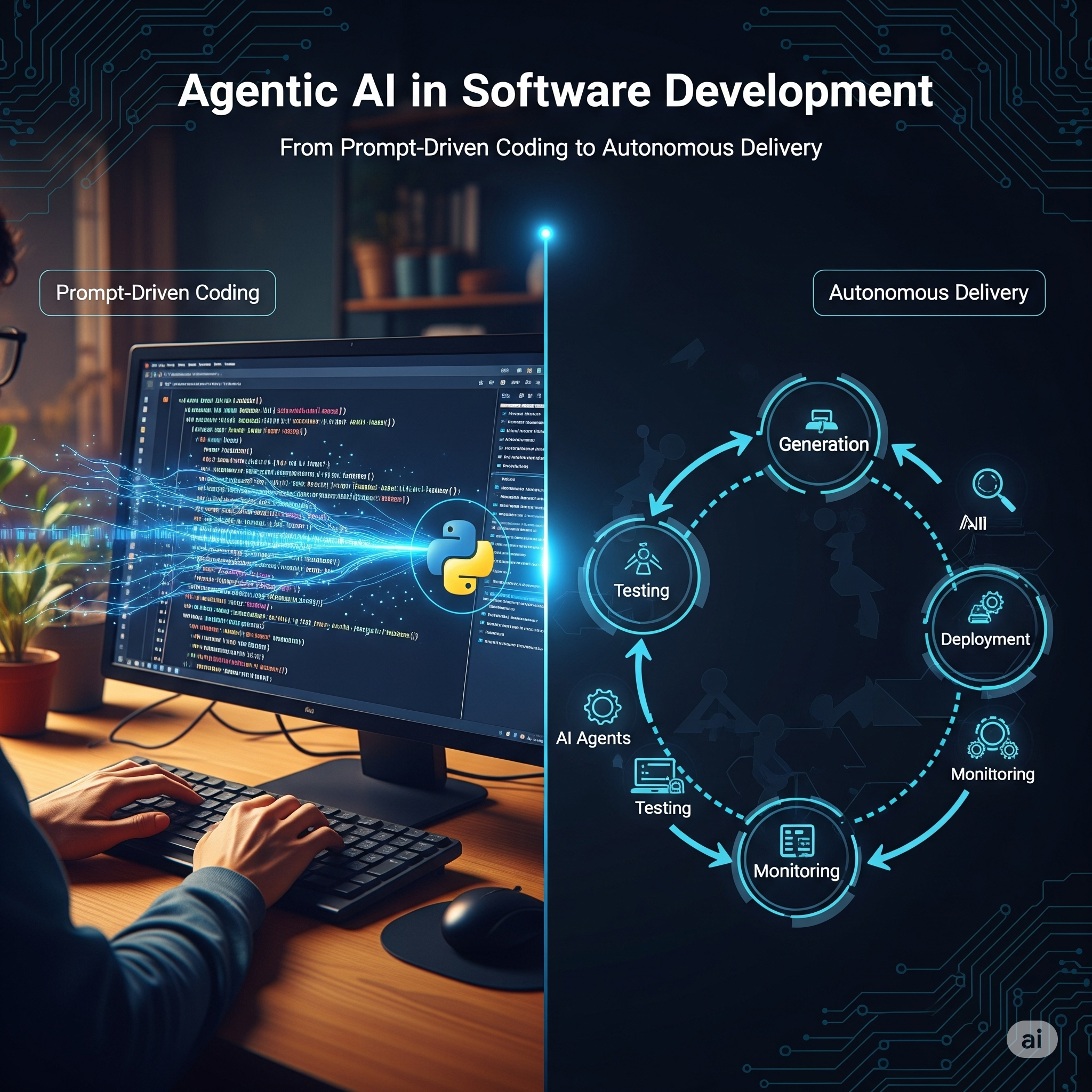Agentic AI in Software Development: From Prompt-Driven Coding to Autonomous Delivery
78 Views
<3 min read
Last updated Loading...

Best Tosan

What Is Agentic AI?
Agentic AI refers to intelligent systems capable of operating independently to achieve defined objectives. These systems can interpret goals, break them into actionable steps, and execute them through iterative feedback loops—adjusting strategies based on real-world outcomes.
In multi-agent setups, multiple specialized AI agents collaborate, communicate, and share knowledge to address complex challenges at scale. In software development, this means agents can manage the full lifecycle—from architecture design and code generation to integration, testing, and deployment—without constant human guidance.
Unlike traditional generative AI, which outputs isolated responses, agentic AI functions as an active development partner, orchestrating entire workflows with contextual awareness and self-correction.
Vibe Coding as the Precursor
Before agentic AI, vibe coding emerged as an exploratory, human-in-the-loop approach where developers used natural language prompts to generate code interactively. While effective for rapid prototyping, vibe coding still required frequent human intervention and direction.
Agentic AI builds on this foundation, aiming for minimal supervision. Instead of generating a single snippet, it can autonomously plan a project, execute multiple stages, test results, and iterate toward completion.
Key differences:
Human Involvement: Vibe coding depends on direct feedback; agentic AI reduces human touchpoints.
Complexity: Vibe coding tackles small, single-step tasks; agentic AI handles multi-step workflows.
Autonomy: Agentic AI can run from goal to delivery without step-by-step instructions.
Example: A developer might use vibe coding to prototype a login feature. An agentic AI system could then integrate the feature into the codebase, test it across environments, and deploy it—all from the initial high-level request.
Core Capabilities of Agentic AI
Autonomy: Executes entire workflows with minimal oversight.
Reasoning & Planning: Breaks down complex goals into structured steps.
Adaptability: Learns from results to refine actions.
Contextual Awareness: Adjusts execution based on current state and constraints.
Collaboration: Works with other agents or humans in parallel.
Integrated Skills: Generates, debugs, optimizes, and deploys code within a single process.
Why It Matters
Agentic AI transforms the software lifecycle in three primary ways:
Speed: Multi-stage processes run in parallel and continuously.
Quality: Built-in testing, validation, and refinement reduce defects.
Capacity: Developers focus on strategic design and innovation, while AI handles repetitive execution.
Real-World Applications
Rapid Prototyping – Converts briefs into functional prototypes.
Legacy Modernization – Refactors and migrates old code to modern architectures.
DevOps Automation – Orchestrates CI/CD pipelines and environment provisioning.
Security Hardening – Identifies and patches vulnerabilities.
Documentation & Review – Generates and updates technical documentation; performs AI-assisted code reviews.
Case Example: A fintech startup used agentic AI to integrate a payment API in hours—parsing documentation, generating code, running tests, and deploying to staging with performance tuning.
Technology Landscape
Auto-GPT – Multi-step task execution.
LangChain – LLM orchestration framework.
LangGraph – Stateful branching workflows.
CrewAI – Coordinated multi-agent execution.
OpenAI Swarm – Agent-to-agent task passing.
Semantic Kernel – Enterprise-ready orchestration.
Choice depends on scale, integration requirements, and risk profile.
Risks and Governance
Autonomy brings responsibility. Key risks include:
Unintended Actions: Tasks chaining into undesired outcomes.
Ethical Concerns: Bias, fairness, and accountability.
Data Security: Vulnerabilities in integrated APIs and services.
Opaque Decision-Making: Limited explainability for certain outputs.
Skill Erosion: Over-reliance reducing human expertise.
Supply Chain Exposure: New dependency management challenges.
Governance Recommendations:
Define clear operational boundaries and decision rights.
Maintain human-in-the-loop oversight for critical actions.
Conduct rigorous pre-deployment testing.
Implement explainable AI mechanisms.
Apply robust cybersecurity and data governance measures.
Continuously monitor and audit agent behavior.
Train teams in AI oversight and escalation processes.
Implementation Guidance
To adopt agentic AI effectively:
Start Small: Begin with well-understood, low-risk tasks.
Specialize Agents: Assign domain-specific roles for efficiency.
Keep Human Checkpoints: Especially for approval stages.
Measure Performance: Use standard development KPIs.
Iterate Continuously: The ecosystem is evolving—expect adjustments.
The Road Ahead
Agentic AI is moving software development toward an era where AI doesn’t just assist—it delivers. Tools like Kiro, Cursor, Windsurf, Lovable, Grok 4, and Claude Code already demonstrate this shift, turning high-level instructions into deployable, production-ready systems. The challenge now is not just to adopt these capabilities but to integrate them responsibly—balancing speed and autonomy with oversight, ethics, and human judgment.
software development
agentic AI
vibe-coding
Comments ( )
0 Likes
Comment
Categories
Latest Posts
Related Posts
No related posts!
